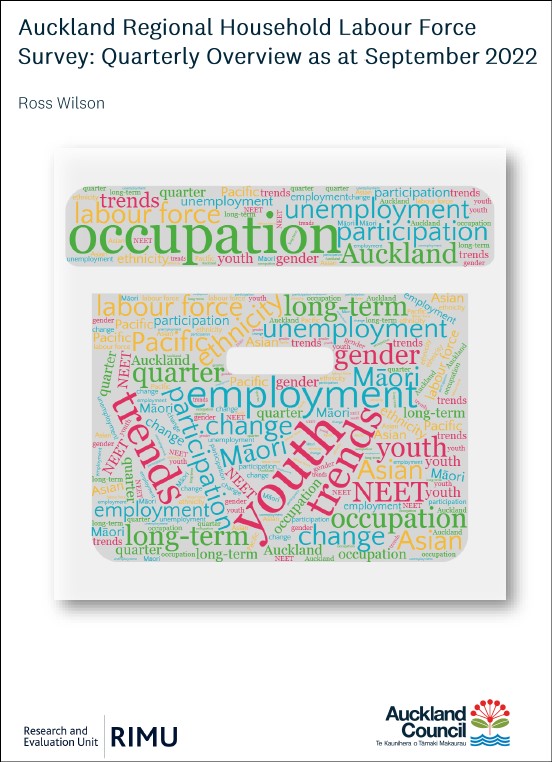Auckland regional household labour force survey: quarterly overview as at September 2022
Author:
Ross WilsonSource:
Auckland Council Research and Evaluation Unit, RIMU | Statistics New ZealandPublication date:
2022Topics:
EconomyAn overview of labour force participation in Auckland, as indicated by results of Stats NZ's quarterly Household Labour Force Survey. HLFS
Overview and highlights
For the September 2022 quarter, compared to the preceding quarter (June 2022):
- Auckland's unemployment rate was 3.3%, compared to 3.4% in June 2022. This and 2021 were Auckland's lowest September overall unemployment rates since 2006.
- The number of people who were unemployed was 32,800, similar to recent quarters.
- Slightly more people were employed 965,200 (+14,800, mostly part-time (+12,600)).
- The number of people not in the labour force (NILF) fell slightly to 361,500.
- At 73.4%, the labour force participation rate rose slightly.
In addition, for the September 2022 quarter:
- The rate of young people aged 15 to 24 not in employment, education or training (NEET) was 10.7%, similar to June 2022 (11.0%) and the rest of New Zealand (10.1%).
Over the year ended September 2022, compared to the year ended September 2021:
- The unemployment rate averaged 3.3%, compared to 4.4% in the 12 months to September 2021 - constituting a reduction of one fourth.
- The unemployment rate for those aged 15 to 19 years averaged 15.4%, a sixth lower than the year before (18.2%)
- The unemployment rate for females averaged 3.7%, a fifth lower than 4.6% a year prior. The rate for males averaged 2.9% (down a third from 4.3% a year prior), so the gap between males and females currently matches the 20-year average (0.8%).
- Changes in unemployment rates varied between ethnic groups, with the largest decrease in the rate of unemployment being among Asian peoples (halving to 2.5%, from 4.5%).
- Pacific people's unemployment rate, 6.6%, was down a quarter from 8.6% the year before, but Māori unemployment fell only slightly to 7.2%, from 7.7%.
- The labour force participation rate (LFPR) averaged 72.4%, slightly above 2021 (71.2%).
- The labour force participation rate for females (67.6%) was above a year prior (65.7%), but for males (77.4%) the change was smaller (from 76.8%).
- Labour force participation rates rose from a year earlier primarily for ages 15-19 (45.1%, up 4.3% from 40.8%) but also all other ages except 20-24 (78.4%, up 0.3%).
- Labour force participation rates were above a year prior for all ethnicities, especially Pacific (65.4% up 2.6%) and Asian (76.3%, a 1.7% rise), but also Māori (68.2%, up 1.1%), but also Pacific (64.4%) and European (73.3% up 1.0%).
In addition, over the year ended September 2022:
- The annual average NEET rate for Auckland was 11.9%, similar to the New Zealand average (11.5%) and lower than the year ended September 2021 (13.2%).
- NEET rates had partly recovered (fallen) to the levels just prior to the pandemic.
- Auckland NEET rates were highest for Māori (22.8%), Southern Initiative area (18.6%), Pacific peoples (16.6%), and those aged 15 to 19 years (14.6%).
Overview published November 2022.
